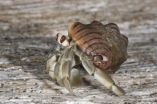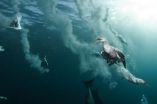(Press-News.org) Social animals usually congregate for protection or mating or to capture bigger prey, but a University of California, Berkeley, biologist has found that the terrestrial hermit crab has a more self-serving social agenda: to kick another crab out of its shell and move into a larger home.
All hermit crabs appropriate abandoned snail shells for their homes, but the dozen or so species of land-based hermit crabs – popular terrarium pets – are the only ones that hollow out and remodel their shells, sometimes doubling the internal volume. This provides more room to grow, more room for eggs – sometimes 1,000 more – and a lighter home to lug around as they forage.
But empty snail shells are rare on land, so the best hope of moving to a new home is to kick others out of their remodeled shells, said Mark Laidre, a UC Berkeley Miller Post-Doctoral Fellow who reported this unusual behavior in this month's issue of the journal Current Biology.
When three or more terrestrial hermit crabs congregate, they quickly attract dozens of others eager to trade up. They typically form a conga line, smallest to largest, each holding onto the crab in front of it, and, once a hapless crab is wrenched from its shell, simultaneously move into larger shells.
"The one that gets yanked out of its shell is often left with the smallest shell, which it can't really protect itself with," said Laidre, who is in the Department of Integrative Biology. "Then it's liable to be eaten by anything. For hermit crabs, it's really their sociality that drives predation."
Laidre says the crabs' unusual behavior is a rare example of how evolving to take advantage of a specialized niche – in this case, land versus ocean – led to an unexpected byproduct: socialization in a typically solitary animal.
"No matter how exactly the hermit tenants modify their shellters, they exemplify an important, if obvious, evolutionary truth: living things have been altering and remodeling their surroundings throughout the history of life," wrote UC Davis evolutionary biologist Geerat J. Vermeij in a commentary in the same journal. For decades, Vermeij has studied how animals' behavior affects their own evolution – what biologists term "niche construction" – as opposed to the well-known Darwinian idea that the environment affects evolution through natural selection.
"Organisms are not just passive pawns subjected to the selective whims of enemies and allies, but active participants in creating and modifying their internal as well as their external conditions of life," Vermeij concluded.
Laidre conducted his studies on the Pacific shore of Costa Rica, where the hermit crab Coenobita compressus can be found by the millions along tropical beaches. He tethered individual crabs, the largest about three inches long, to a post and monitored the free-for-all that typically appeared within 10-15 minutes.
Most of the 800 or so species of hermit crab live in the ocean, where empty snail shells are common because of the prevalence of predators like shell-crushing crabs with wrench-like pincers, snail-eating puffer fish and stomatopods, which have the fastest and most destructive punch of any predator.
On land, however, the only shells available come from marine snails tossed ashore by waves. Their rarity and the fact that few land predators can break open these shells to get at the hermit crab may have led the crabs to remodel the shells to make them lighter and more spacious, Laidre said.
The importance of remodeled shells became evident after an experiment in which he pulled crabs from their homes and instead offered them newly vacated snail shells. None survived. Apparently, he said, only the smallest hermit crabs take advantage of new shells, since only the small hermit crabs can fit inside the unremodeled shells. Even if a crab can fit inside the shell, it still must expend time and energy to hollow it out, and this is something hermit crabs of all sizes would prefer to avoid if possible.
INFORMATION:
The work was funded by UC Berkeley's Miller Institute.
Hermit crabs socialize to evict their neighbors
Terrestrial crabs, constrained by lack of suitable shells, must take others' remodeled homes
2012-10-26
ELSE PRESS RELEASES FROM THIS DATE:
NASA sees Tropical Storm Son-tinh moving through South China Sea
2012-10-26
NASA's Terra satellite got a good look at Tropical Storm Son-tinh moving through the South China Sea and headed for landfall in Vietnam.
NASA's Terra satellite flew over Son-Tinh on Oct. 26 at 0305 UTC (Oct. 25 at 11:05 p.m. EDT) and the Moderate Resolution Imaging Spectroradiometer (MODIS) instrument aboard captured a visible image of the storm. At the time, Son-tinh's western edge had already moved away from the Philippines. The image revealed powerful thunderstorms in the northwestern quadrant of the storm, and in the storm's center.
On Oct. 26 at 1500 UTC, Tropical ...
Drug shows promise in animal model of Alzheimer's and Parkinson's with dementia
2012-10-26
New research presented in October at the 6th Neurodegenerative Conditions Research and Development Conference in San Francisco demonstrates the role of the investigational compound IRX4204 in alleviating cognitive decline in animal models of Alzheimer's disease (AD). The presentation entitled "Investigation of the RXR-specific agonist IRX4204 as a Disease Modifying Agent of Alzheimer's Disease Neuropathology and Cognitive Impairment" was made by lead researcher Giulio Maria Pasinetti, MD, PhD, of the Mount Sinai School of Medicine in New York City.
IRX4204 is a retinoid ...
Stroke survivors who smoke raise risk of more strokes, heart attack, death
2012-10-26
Stroke survivors who smoke put themselves at a greater risk of additional strokes, heart attack or death than those who never smoked, according to new research in the American Heart Association's journal Stroke.
Those who quit smoking before their stroke also had less risk of poorer outcomes than current smokers, researchers found.
Researchers in Melbourne, Australia, tracked 1,589 patients who experienced a first or recurrent stroke in 1996-99. They followed them for 10 years, using medical records and in-person and telephone interviews, and tracked demographics, ...
C'est difficile
2012-10-26
In a new study out today, researchers used mice to identify a combination six naturally occurring bacteria that eradicate a highly contagious form of Clostridium difficile, an infectious bacterium associated with many hospital deaths. Three of the six bacteria have not been described before. This work may have significant implications for future control and treatment approaches.
The researchers found that this strain of C. difficile, known as O27, establishes a persistent, prolonged contagious period, known as supershedding that is very difficult to treat with antibiotics. ...
Researchers at the doorstep of stem cell therapies for MS, other myelin disorders
2012-10-26
When the era of regenerative medicine dawned more than three decades ago, the potential to replenish populations of cells destroyed by disease was seen by many as the next medical revolution. However, what followed turned out not to be a sprint to the clinic, but rather a long tedious slog carried out in labs across the globe required to master the complexity of stem cells and then pair their capabilities and attributes with specific diseases.
In a review article appearing today in the journal Science, University of Rochester Medical Center scientists Steve Goldman, ...
Traditional fisheries management approach jeopardizes marine ecosystems worldwide
2012-10-26
STONY BROOK, NY– In a Perspectives article, "The Risks of Overfishing," published today in the journal Science, Dr. Ellen K. Pikitch, executive director of the Institute for Ocean Conservation Science and professor at Stony Brook University, cautions against continuing traditional fisheries management. According to Dr. Pikitch, current and recent studies demonstrate the need for "a more precautionary approach to fisheries management, in which fishing is restricted to those places and amounts where it can be conducted safely and with minimal risk of jeopardizing the integrity ...
'Adoption activity days' can help children find new families
2012-10-26
Children's parties or activity days, where prospective adopters meet children awaiting adoption, could be part of the solution to the current adoption crisis, according to research that will be showcased during the Economic and Social Research Council (ESRC) Festival of Social Science.
"Such parties or activity days went out of fashion in the 1980s but no one is sure why," says Katherine Runswick-Cole of Manchester Metropolitan University who led the research. "However, our pilot study has shown an overwhelmingly positive response from practitioners, adopters and the ...
A black widow's Tango Mortale in gamma-ray light
2012-10-26
This press release is available in German.
Pulsars are the compact remnants from explosions of massive stars. Some of them spin around their own axis hundreds of times per second, emitting beams of radiation into space. Until now, they could only be found through their pulsed radio emissions. Now, scientists at the Max Planck Institute for Gravitational Physics (Albert Einstein Institute/AEI) in Hanover assisted by the Max Planck Institute for Radio Astronomy have discovered a millisecond pulsar solely via its pulsed gamma radiation. A new data analysis method developed ...
Smoking takes 10 years off life expectancy in Japan, not 4 as previously thought, experts warn
2012-10-26
Smoking reduces life expectancy by ten years in Japan, but much of the risk can be avoided by giving up smoking, a paper published on bmj.com today shows.
Previous studies in Japan suggested smoking reduced life expectancy by only a few years compared with about ten years in Britain and the USA. This new report, from researchers in Oxford and Japan, investigates the impact of smoking on mortality in a large group of Japanese people who were living in Hiroshima or Nagasaki in 1950. The findings are, however, nothing to do with radiation exposure from the bombs.
The ...
US investment in biomedical and health research on downward trend
2012-10-26
WASHINGTON, DC—October 25, 2012—Biomedical and health research and development (R&D) spending from all sources declined by more than $4 billion or 3% between FY10 and FY11 according to Research!America's 2011 U.S. Investment in Health Research report. This represents the first drop in overall spending since Research!America began compiling the data in 2002.
The decline follows an uptick in research funding attributed to the American Recovery and Reinvestment Act (ARRA), which allocated $10.4 billion to the National Institutes of Health (NIH) over two fiscal years (2009-2010). ...
LAST 30 PRESS RELEASES:
Jeonbuk National University study shows positive parenting can protect adolescents against self-harm
Surface-engineered ZnO nanocrystals to tackle perfluoroalkyl substance contamination
This new understanding of T cell receptors may improve cancer immunotherapies
A new fossil face sheds light on early migrations of ancient human ancestor
A new immunotherapy approach could work for many types of cancer
A new way to diagnose deadly lung infections and save lives
40 percent of MRI signals do not correspond to actual brain activity
How brain-inspired algorithms could drive down AI energy costs
Gum disease may be linked to plaque buildup in arteries, higher risk of major CVD events
Contrails are a major driver of aviation’s climate impact
Structure of dopamine-releasing neurons relates to the type of circuits they form for smell-processing
Reducing social isolation protects the brain in later life
Keeping the heart healthy increases longevity even after cancer
Young adults commonly mix cannabis with nicotine and tobacco
Comprehensive review illuminates tau protein's dual nature in brain health, disease, and emerging psychiatric connections
Book prepares K-12 leaders for the next public health crisis
Storms in the Southern Ocean mitigates global warming
Seals on the move: Research reveals key data for offshore development and international ecology
Sports injuries sustained during your period might be more severe
World's first successful 2 Tbit/s free-space optical communication using small optical terminals mountable on satellites and HAPS
Can intimate relationships affect your heart? New study says ‘yes’
Scalable and healable gradient textiles for multi‑scenario radiative cooling via bicomponent blow spinning
Research shows informed traders never let a good climate crisis go to waste
Intelligent XGBoost framework enhances asphalt pavement skid resistance assessment
Dual-function biomaterials for postoperative osteosarcoma: Tumor suppression and bone regeneration
New framework reveals where transport emissions concentrate in Singapore
NTP-enhanced lattice oxygen activation in Ce-Co catalysts for low-temperature soot combustion
Synergistic interface engineering in Cu-Zn-Ce catalysts for efficient CO2 hydrogenation to methanol
COVID-19 leaves a lasting mark on the human brain
Scientists use ultrasound to soften and treat cancer tumors without damaging healthy tissue
[Press-News.org] Hermit crabs socialize to evict their neighborsTerrestrial crabs, constrained by lack of suitable shells, must take others' remodeled homes



